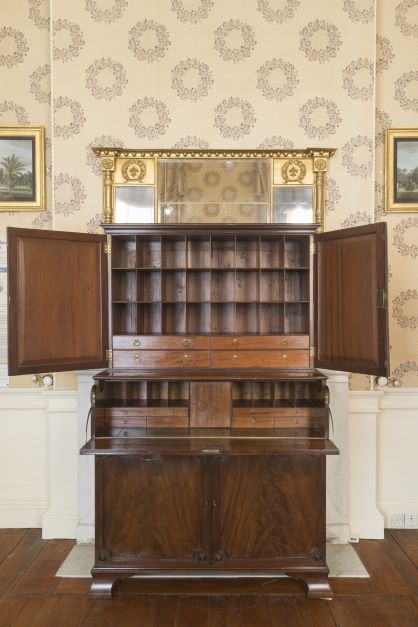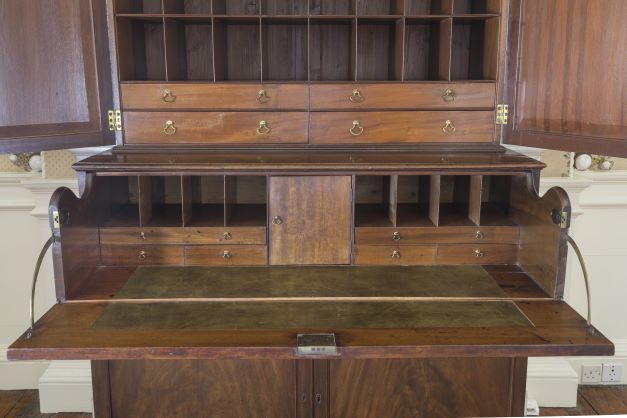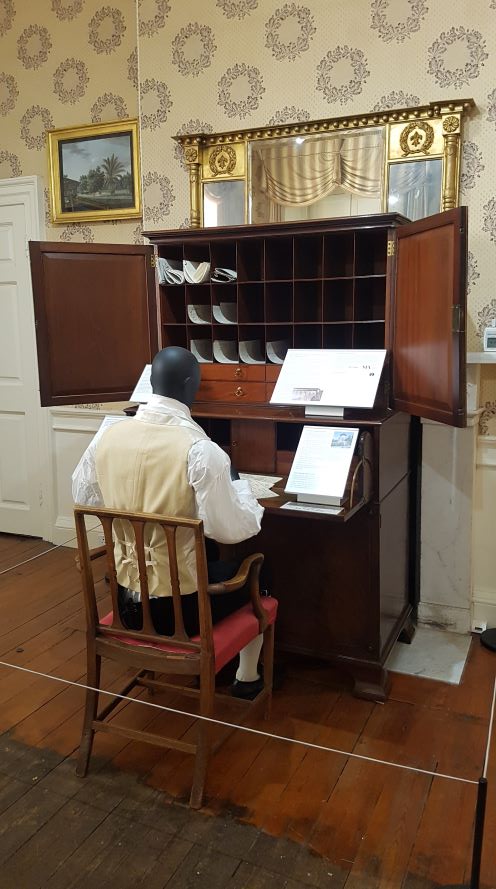Mahogany secretaire, designed and made between 1775 and 1779 by Thomas Chippendale Snr (1718-1779) and Thomas Chippendale Jnr (1749-1822). Acquired by the Paxton Trust in 2022 with a grant of £19,000 from the National Fund for Acquisitions, funded by the Scottish Government.

This outstanding mahogany secretaire, or writing desk, designed and made by the master cabinetmakers Thomas Chippendale Senior and his son, also called Thomas, was commissioned by the enslavers Ninian and Penelope Home for their recently-purchased home, Paxton House in the Scottish Borders. Based mainly on the Caribbean Island of Grenada, they owned or part-owned two plantations in Grenada and one on the island of Mustique. Ninian, who became Lieutenant-Governor of Grenada in 1792, was murdered in Fédon’s Uprising in 1795.

The couple visited Scotland intermittently, buying Paxton from Ninian’s uncle, Patrick Home, in 1773. Between 1774 and 1791 they filled the house almost exclusively with furniture from the Chippendale firm. Ninian required writing furniture in nearly every room in the house to conduct his estate business. This unique secretaire is beautifully constructed with multiple pigeonholes and drawers for filing documents, and a discrete fold-down secretaire drawer. Exceptionally, this piece retains not only the marbled paper-lined trays in the base that were a signature Chippendale feature, but also fragments of the original baize dust covers which protected the documents held within. The secretaire is made from highest quality Jamaican mahogany cut down by enslaved African people clearing tropical rainforest for plantations. The Homes made enough money from the sugar, cocoa, and coffee grown by around 450-500 enslaved African labourers to commission this piece and the interiors of the Drawing Room and Dining Room from Chippendale and Robert Adam (1728-1792). The Chippendale furniture collection at Paxton House, one of the largest in the world, is of national and international importance.

The secretaire was continually in use by the family at Paxton House until 1970 when it was sold and ended up in private collections in the USA. The acquisition of this masterpiece has been supported with generous grants from the National Fund for Acquisitions, the Art Fund, The Chippendale Society, and the Museums Association’s Beecroft Bequest. A private donor kindly supported additional costs including transportation and conservation. The vendors, Kevin Kleinbardt and Ahna (Hogeland) Petersen of Yew Tree House and Clinton Howell, generously reduced the sale price to support the return of the secretaire to its original home.
The secretaire is now displayed at Paxton House, in the room for which it was made, within the context of a new permanent exhibition, Caribbean Connections and Slavery, developed in partnership with Descendants, an African and Caribbean group. It also features in an online trail accessed via https://paxtonhouse.co.uk/news/sugar-slavery/. The exhibition and trail launched on 4 June 2022, the 30th anniversary of Paxton House opening to the public. Both have been supported by grants from the Museums Association’s Esmée Fairbairn Collections Fund and Museums Galleries Scotland.
Dr Fiona Salvesen Murrell
Curator
The Paxton Trust
